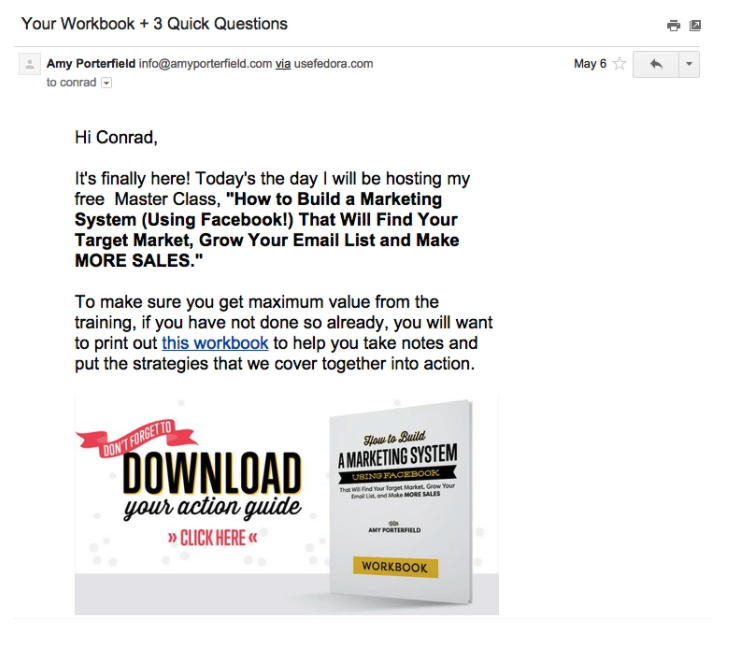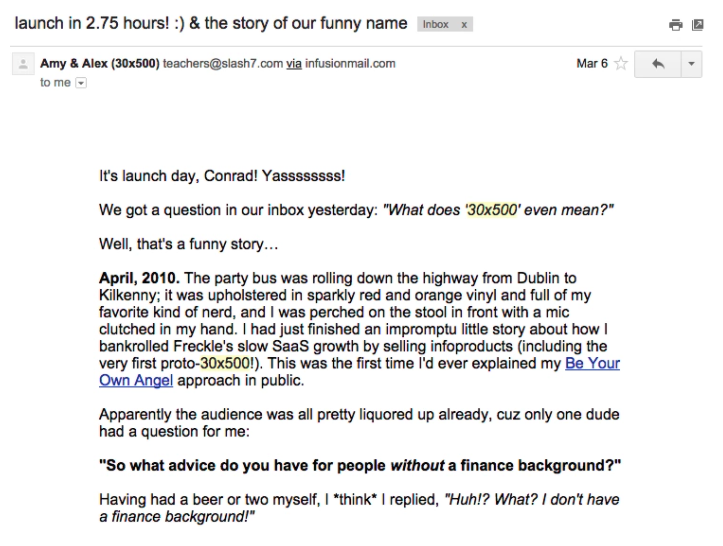7 product launch emails [tried-and-tested examples]
![7 product launch emails [tried-and-tested examples]](https://assets-global.website-files.com/65393b768d06ee4c16d24a33/65a84422c659540061bfbb21_product-launch-emails.webp)
In the world of online course launches, the most successful ones often begin with a conversation. Creating a productive back and forth with your audience builds anticipation for your course launch. To help you set off on the right foot, we’ve done the research to find product launch emails that will result in more sales for you.
There is no magic number when it comes to creating a launch conversation through email. The key is imply to use the conversation to help define what your product actually is. The great part about this strategy is that you only need an email list of a few hundred people to start getting results and data about your approach. While, we’re going to focus on online course launches, the learnings from this process can be easily translated to launches of all types, whether you’re promoting your product on KickStarter or at a tech startup. We looked into hundreds of successful course launches and pre-sales.
7 product launch emails to consider
Here are seven basic email types almost each of these launches has:
- Survey email
- Give email
- Interest list email
- Anticipation email
- Offer email
- Common questions email
- Closing email
Each of these emails has a specific purpose—and takes advantage of psychology we’re all influenced by. Particularly:
- Liking
- Social Proof
- Reciprocity
- Scarcity
- Consistency
- Authority
- Anticipation
For more of the psychology side, check out Robert Cialdini’s book Influence or Jeff Walker’s book, aptly called, Launch.
Let’s check out some examples of each of these types of emails.
1. Survey email
The point of the survey email is to quickly collect email addresses and get feedback from your potential audience. Imagine knowing what people want before you sell something. You’ll use these responses to tailor your offer and eventual product.
You can do this by sending out an email to your interest list that asks people for “the one thing they are struggling with right now.”
Here’s an example from the founding of GrowHack with Mattan Griffel. This email had an impressive 10% response rate from 3,000 welcome emails sent.

With a survey email, don’t try to sell your product. Don’t include a price. This email is simply a means to find out who’s interested and discover their very specific problems and pain points.
The more closely you can tailor your offer to the exact problems people on your list describe, the more valuable your product becomes and the more people will be willing to pay for it.
This example of product launch emails has the two-fold benefit of also creating a personal connection with your audience and building feelings of trust. It shows that you care about their personal problems, to the point where you want to go so far as to solve them with your course.
SurveyMonkey is a great resource which you can use to create an email survey very quickly at no cost. You can simply link to your SurveyMonkey in your email.
A word to the wise, if you’re linking to a survey instead of asking someone to reply to an email, get specific in the questions you ask to foster actionable responses, while not being lengthy (or people won’t finish your survey) like so:

You can also include multiple questions in the Survey Monkey, most people who start your survey will end up completing it if you only show one question at a time.
2. Give email
One of the best ways to turn potential customers into fans is to follow the give, give, give philosophy before you make any kind of offer. Giving helps build a sense of reciprocity. If you give value, someone naturally wants to return the favor.
To start this type of product launch email, begin by giving your reader something valuable. This giveaway can come in the form of a blog post, worksheet, video training, audio files—almost anything works as long as it’s high quality and free.
Here’s an example of a workbook from Amy Porterfield:

3. Interest list email
This email will help you segment your audience into lists based on who they are and their interests.
For example, if you’re writing to all vegetarians, you might want to know who in your audience is just a vegetarian and who is a vegan so you know how to tailor your content. Or, if you’re starting a StartUp Sales Bootcamp like Juliana Crispo you might want to know who is a sales executive and who is a founder.

This is a great email to start building anticipation with your audience and building conversation.
Hold back from including any mention about your exact offer in this email, you’re just looking to learn about your audience and better categorize them so you can send them specific communication in the future.
For Juliana’s presale specifically, more than 50% of those who signed up for her interest list turned into eventual paying customers.
A couple ways to create your interest list page include:
- MailChimp is a simple way to create a basic interest list page.
- You can use the Teachable course page editor to collect emails.
- Another option is Instapage to create your landing page and collect interested emails.
- Unbounce can be used in the same way.
4. Anticipation email
Telling an engaging story is a great way to build interest and trust with your audience. It’s one of the more compelling examples of product launch emails. One way to start is by telling your personal story about why you created this content. A story helps humanize you and emphasizes the outcome you’ll lead someone to through your course.
Here’s how Amy Hoy of 30X500 goes into her story and builds anticipation like this:

In your story, know that it’s OK to say you’re not experienced with teaching. Anecdotally, we’ve found that people don’t necessarily always want an expert, they want someone who has just been through what they’re currently going through.
This way, you understand the trouble spots and the language that helped you understand better than a seasoned expert who might pass over important assumptions. Here are a couple strategies to get around the the curse of knowledge from Janet Choi of Customer.io.
5. Offer email
This is where you let your audience know they can actually pay for your product or at least get the pre-sale.
Here’s the opening to the offer email from Bryan Harris of Video Fruit:

There is a ton of information out there on how to handle pricing and how to approach mentioning it in an email of this type. One approach is to do what Debbie LaChusa did with her course, which is to offer it at a discounted price prior to launch for just a short period of time. This creates scarcity and urgency around your offer.
Nat Eliason successfully launched his course, Become a Technical Marketer, letting his audience know that the cost of the course would go up after it officially launched.
Another aspect of this email can be sending someone to a great landing page. We loved Bree Noble’s story. When she was preselling her online course Female Musician Academy, linking to a great looking sales page helped.
“I was able to pre-sell my online course (Female Musician Academy) to 15 people at $290 new students told me that my Teachable school was so beautiful that they could tell the course was going to be amazing.”

By linking to strong online assets and by creating strong written content around the course, Bree demonstrated some inherent social proof, which she used to help monetize her course before launch.
Alternatively you can also include bonuses and not explicitly state your price in your open email, like in Marie Forleo and Laura Belgray of Copy Cure.

In your email, be sure to link to your online properties where people can buy your product and make sure you have standout visuals.
6. Common questions email
What this email does is pretty self-explanatory. You’re going to answer the common questions your audience might be sending you.
This is going to keep people in your course who might be confused and haven’t gone so far to bring up their hesitations with you. It also preemptively saves you time by resolving common customer support questions.
Check out Jeff Walker’s email with his Seed Launch program:

It’s also a great opportunity to create some social proof. After all, if there are common your offer, right?
7. Closing email
This is where you’ve got to seal the deal. In this email, you’ve got to let people know that the presale is ending and the price of the course is going to go up significantly or the course will close. You can use social proof and list how many people signed up to further incentivize those still on the edge.
We like the way Amy and Alex did this in 30×500 generating scarcity and giving social proof.

Not only does this push your audience out of procrastination mode and into action, but also, it helps you handle a constant influx of students. It’s easiest to keep everyone on the same path. New users take time to onboard and it’s better to handle in batches rather than individually.
Keep in mind, more than one closing email can be helpful. Some customers will want a final-chance-to-buy type of email before you close your offer or enrollment so they don’t miss out.
Keep in mind, there are a lot of pre-sale or launch email variations that can be effective.
Do you want to combine a give email with an interest list email? Do you want to add three anticipation or closing emails? You can mix and match and layer each of these emails to create your own online email launch sequence.
Try adding these emails to start getting more feedback on your product before launching, build your relationships, anticipation and of course, get more sales.
Next steps
One of the best ways we’ve found to learn about launching is to study other great launches.
Sign up for courses from experienced creators and check out their techniques. While someone else’s audience might not be the same as yours, you can still learn a lot about launching by studying their email tactics. Did someone else’s launch work on you?
Here are a few examples of courses with effective launch sequences to get you kicked off:
Tags:
More like this

Your weekly dose of creative chat and Teachable updates. Get our weekly newsletter.







